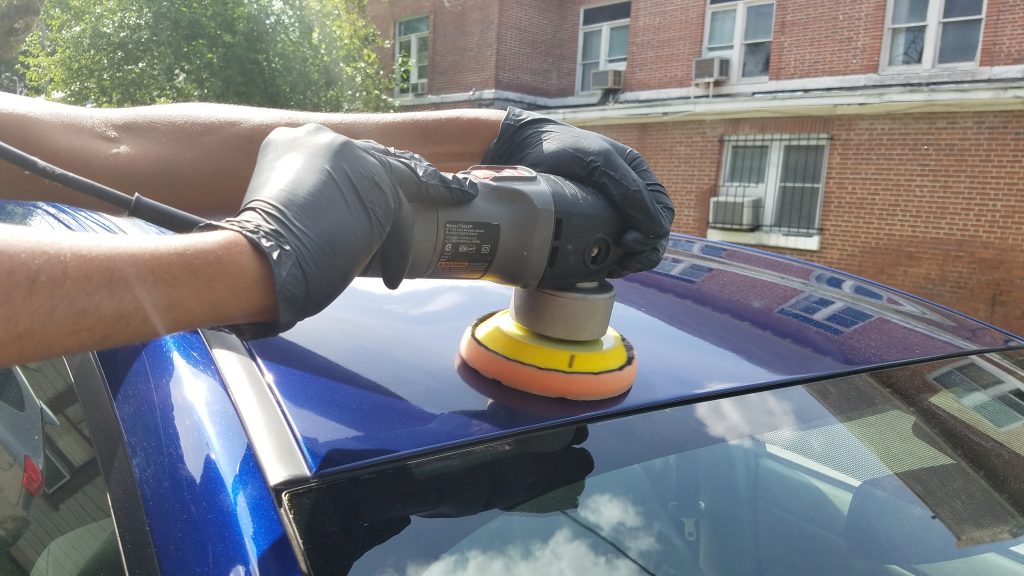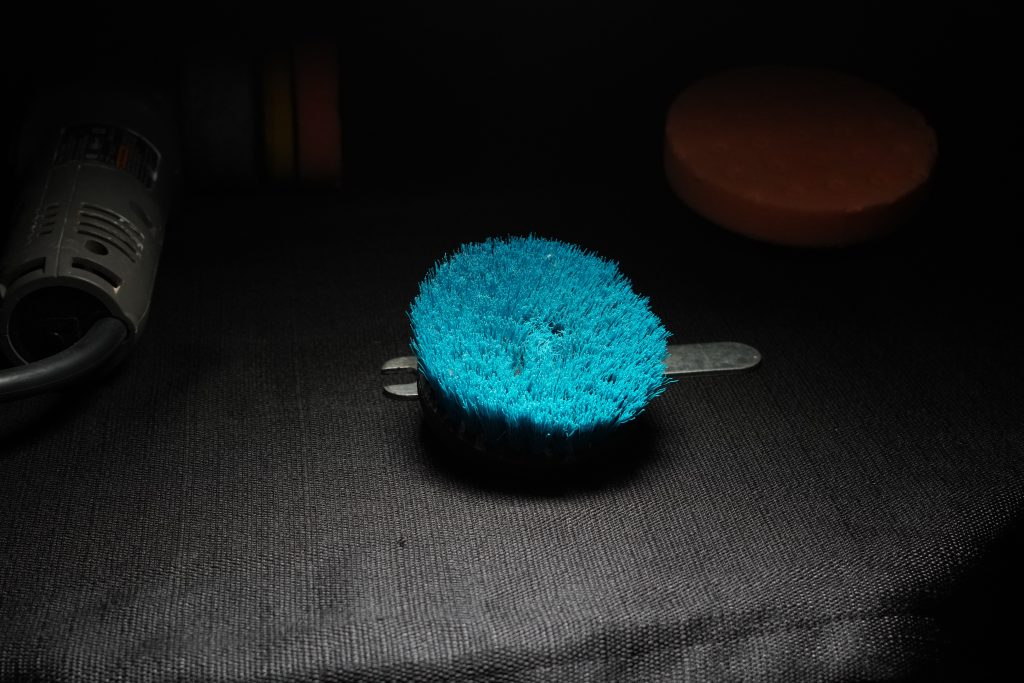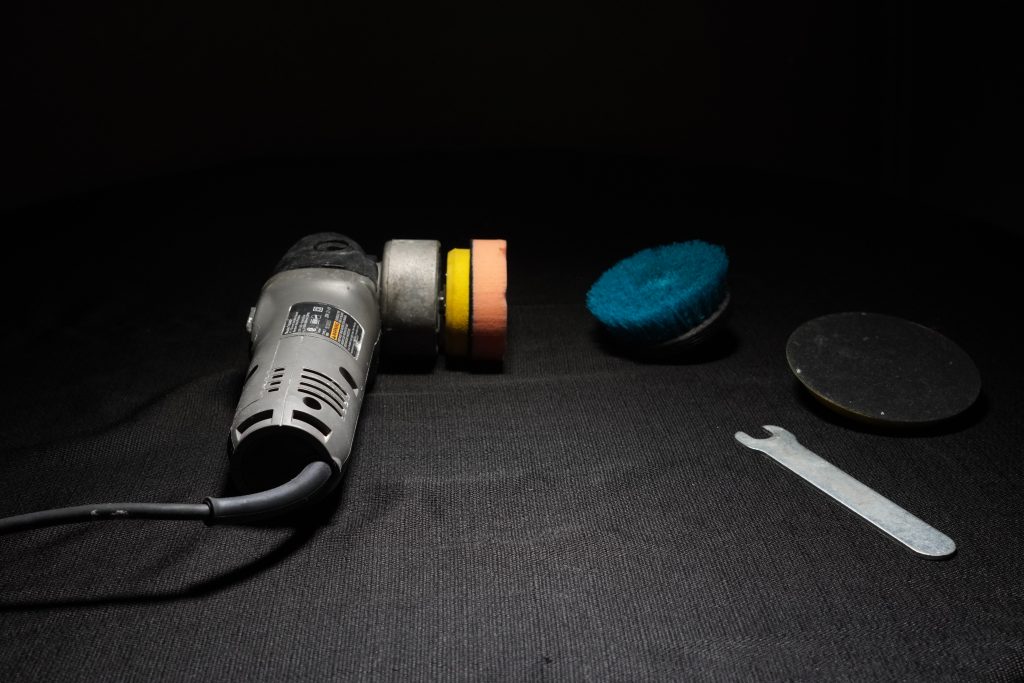The Many Features Of An Entry Level Beginner Polisher
by Rodney TatumThe Porter Cable 7424 XP Random Orbital Buffer is often my recommendation for those who are new to polishing as their first polisher. The two practical benefits of the Porter Cable as a first polisher are the price and the multiple backing plate options. This makes the Porter Cable an excellent value option.
With the use of the included wrench you can change the backing plate and turn the Porter Cable 7424XP into a 3-, 4-, 5-, or 6-inch unit quickly and easily.
I would not recommend the 6-inch plate and pad combination for anything but (maybe) a light cleaner polish application. The Porter Cable tends to not rotate very well, in many situations, working with those larger dimensions.
Below I am using a medium aggressive pad (Lake Country CCS Orange) with various Menzerna polishes for a 2 and 3 step (paint correction) polishing with a 5-inch backing plate.

Starting out the most practical backing plates I have used for polishing, and what I recommend, are the 3-inch and the 5-inch options.
Having these options in one polisher at the current price of $124.99, takes pressure off the casual or serious car enthusiast to upgrade in the short run (and long term). It also gives you more flexibility with respect to future purchases. For serious enthusiasts and budding professionals, the Porter Cable can complement your gradual addition of polishers. My second polisher that I added to my collection was the Rupes Duetto. Many people make the Rupes 15 or even the Rupes 21 polisher their next purchase, using the Porter Cable temporarily in place of the Rupes Mini.

In addition to the available backing plate options, you can also attach a carpet brush to the Porter Cable. I usually do not use the brush attachment for the Porter Cable, but this is also an available option.
Pictured below to the left: Porter Cable 7424XP with a 3-inch polishing set up.

Detailed Image sells carpet brushes at 3 levels of aggressiveness for carpets and fabric seats (light duty, medium duty, and heavy duty). I have only used medium duty strength brushes for carpets and fabric at a max speed of 5 to protect against damaging the stitching of fabric.
For your pad setup, I recommend testing out some pad options, sizes, etc. before you make a significant investment. Below are a few questions I recommend asking yourself:
A.) Are you content with this set up?
B.) Are you considering (or believe) in the future you will upgrade your polisher selection to a long throw, i.e. Rupes random orbital or Griots (G15, G21) polisher?
If option A, the polish and pad combination I started with would be a good budget option. Those are the Lake Country CCS pads.
If option B, I would invest in the Lake Country SDO pads as these withstand the long throw polishers like the Rupes units, meaning you can easily use the pads you invested in if/when you upgrade polishers.
After you choose your polisher, do not forget to check out some of the great polishing tutorials here on the blog. One of my favorites is this article by Ivan Rajic.
Related Posts
- Polishing Products Part 1 – My Experience With The Rupes Polishers And Others
- Beginner Paint Correction Kit: Getting Started on a Budget
- Window Etching & Stain Removal | Getting the Most Out of Your Meguiar’s Cutting Discs
- Audi R8 Spyder Detail and Modesta Coating
- Ferrari 348 Detail for Cavallino Classics









I bought and used a Griot’s Garage random orbital buffer for many years, and always had good results with that level of polisher. I used exclusively Lake Country foam pads, mostly the CCS line. I also use mostly Meguiars compounds and polishes but have played around with numerous sealants and waxes. I have gone over to Ceramic last step products and love them. Age has taken a toll on me as I now tire more easily and a complete paint detail often takes several days to complete. In hopes of cutting down on the time and fatigue issues, I recently purchased a Harbor Freight 20mm Long-Throw random buffer and love it! Works much faster than the Griots or Porter-type Cable basic buffers, and it’s only $100 (or less on sale). It makes a lot more sense, cost-wise, than the upscale buffers that cost upwards of $300. If I was a professional detailer, I might be persuaded to buy one of the expensive buffers, but for a hobbyist, the Harbor Freight is cost-effective and will probably outlast me. I modded it by cleaning out the crappy stock gear grease and replacing it with good stuff. I think this unit is a great option to the entry-level buffers.
One other point to add: these long throw buffers are considerably more powerful than the entry-level models, and care must be taken not to buff through your clear coat and color/primer layers. Don’t press too hard and start with a polish and mildly aggressive pad, NOT with a compound and Orange Lake Country pad. Start with a polish and if that isn’t doing the job, move up to more aggressive polishes/pads.
The Porter Cable is still my preferred polisher.
I have Rupes Nano, Mini, Duetto, 21, and a Flex 3401, but my first choice is the PC.
Super versatile, easy to use, durable, reliable, effective, and affordable.
Sorry, this wasn’t supposed to be a reply to you, but the article itself!
Another great article; thanks. Simple question, though. What is the definition of a “short throw” v. “long throw” polisher?
Hi Dave,
Here’s a link to our Detailing Dictionary for the definition of “Throw” – https://www.detailedimage.com/Auto-Detailing-Guide/Dictionary/Throw/. It’s basically the distance the center of the backing plate travels from the center of the polisher. Short throws would be something like the Griot’s Garage G9 Random Orbital Polisher (https://www.detailedimage.com/Griots-M56/G9-Random-Orbital-Polisher-P2051/6-S1/) at 9mm vs the Griot’s Garage Long Throw Orbital Polisher at 15mm or 21mm (https://www.detailedimage.com/Griots-M56/Long-Throw-Orbital-Polisher-P2250/G15-S1/). Long throw polishers are usually bigger and cover more surface area when polishing.
If you have any other questions please let us know.
Mike @ DI
Perfect. And thanks for the link!
Thank you! And sorry for the delayed response. It is pretty much what Mike said here.